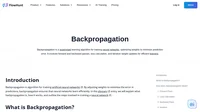Activation functions are fundamental to the architecture of artificial neural networks (ANNs), significantly influencing the network’s capability to learn and execute intricate tasks. This glossary article delves into the complexities of activation functions, examining their purpose, types, and applications, particularly within the realms of AI, deep learning, and neural networks.
What is an Activation Function?
An activation function in a neural network is a mathematical operation applied to the output of a neuron. It determines whether a neuron should be activated or not, introducing non-linearity into the model, which enables the network to learn complex patterns. Without these functions, a neural network would essentially act as a linear regression model, regardless of its depth or number of layers.
Purpose of Activation Functions
- Introduction of Non-linearity: Activation functions enable neural networks to capture non-linear relationships in the data, essential for solving complex tasks.
- Bounded Output: They restrict the output of neurons to a specific range, preventing extreme values that can impede the learning process.
- Gradient Propagation: During backpropagation, activation functions assist in calculating gradients, which are necessary for updating weights and biases in the network.
Types of Activation Functions
Linear Activation Functions
- Equation: ( f(x) = x )
- Characteristics: No non-linearity is introduced; outputs are directly proportional to inputs.
- Use Case: Often used in the output layer for regression tasks where output values are not confined to a specific range.
- Limitation: All layers would collapse into a single layer, losing the network’s depth.
Non-linear Activation Functions
- Sigmoid Function
- Equation: ( f(x) = \frac{1}{1 + e^{-x}} )
- Characteristics: Outputs range between 0 and 1; “S” shaped curve.
- Use Case: Suitable for binary classification problems.
- Limitation: Can suffer from the vanishing gradient problem, slowing down learning in deep networks.
- Tanh Function
- Equation: ( f(x) = \tanh(x) = \frac{2}{1 + e^{-2x}} – 1 )
- Characteristics: Outputs range between -1 and 1; zero-centered.
- Use Case: Commonly used in hidden layers of neural networks.
- Limitation: Also susceptible to the vanishing gradient problem.
- ReLU (Rectified Linear Unit)
- Equation: ( f(x) = \max(0, x) )
- Characteristics: Outputs zero for negative inputs and linear for positive inputs.
- Use Case: Widely used in deep learning, particularly in convolutional neural networks.
- Limitation: May suffer from the “dying ReLU” problem where neurons stop learning.
- Leaky ReLU
- Equation: ( f(x) = \max(0.01x, x) )
- Characteristics: Allows a small, non-zero gradient when the unit is inactive.
- Use Case: Addresses the dying ReLU problem by allowing a small slope for negative values.
- Softmax Function
- Equation: ( f(x_i) = \frac{e^{x_i}}{\sum_{j} e^{x_j}} )
- Characteristics: Converts logits into probabilities that sum to 1.
- Use Case: Used in the output layer of neural networks for multi-class classification problems.
- Swish Function
- Equation: ( f(x) = x \cdot \text{sigmoid}(x) )
- Characteristics: Smooth and non-monotonic, allowing for better optimization and convergence.
- Use Case: Often used in state-of-the-art deep learning models for enhanced performance over ReLU.
Applications in AI and Deep Learning
Activation functions are integral to various AI applications, including:
- Image Classification: Functions like ReLU and Softmax are crucial in convolutional neural networks for processing and classifying images.
- Natural Language Processing: Activation functions help in learning complex patterns in textual data, enabling language models to generate human-like text.
- AI Automation: In robotics and automated systems, activation functions aid in decision-making processes by interpreting sensory data inputs.
- Chatbots: They enable conversational models to understand and respond to user queries effectively by learning from diverse input patterns.
Challenges and Considerations
- Vanishing Gradient Problem: Sigmoid and Tanh functions can lead to vanishing gradients, where gradients become too small, hindering the learning process. Techniques like using ReLU or its variants can mitigate this.
- Dying ReLU: A significant issue where neurons can get stuck during training and stop learning. Leaky ReLU and other modified forms can help alleviate this.
- Computational Expense: Some functions, like sigmoid and softmax, are computationally intensive, which might not be suitable for real-time applications.
Artificial Neural Networks (ANNs)
Explore Artificial Neural Networks (ANNs) and discover their role in AI. Learn about types, training, and applications across various industries.
Introduction to AI Intent Classification
Discover how AI Intent Classification enhances interactions, boosts user satisfaction, and streamlines business operations across various sectors.



